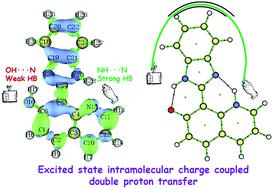当前位置:
X-MOL 学术
›
New J. Chem.
›
论文详情
Our official English website, www.x-mol.net, welcomes your
feedback! (Note: you will need to create a separate account there.)
Deciphering the excited state intramolecular charge-coupled double proton transfer in an asymmetric quinoline–benzimidazole system
New Journal of Chemistry ( IF 2.7 ) Pub Date : 2020-07-13 , DOI: 10.1039/d0nj01651a Gulshan Kumar 1, 2, 3 , Kamaldeep Paul 1, 2, 3 , Vijay Luxami 1, 2, 3
New Journal of Chemistry ( IF 2.7 ) Pub Date : 2020-07-13 , DOI: 10.1039/d0nj01651a Gulshan Kumar 1, 2, 3 , Kamaldeep Paul 1, 2, 3 , Vijay Luxami 1, 2, 3
Affiliation

|
8-(1H-Benzo[d]imidazol-2-yl)quinolin-7-ol (HQB) has structural asymmetry and contains double hydrogen bonds (HBs), which undergo excited state intramolecular charge transfer and double proton transfer (ESICT/ESIDPT). HQB exhibits three absorption peaks at 360, 315, and 305 nm. On photoexcitation, HQB displays dual emission at 420 and 570 nm, with Stokes’ shifts of 60 and 210 nm, respectively. The dual emission with large Stokes’ shifts and growth of an absorption shoulder peak at ∼400 nm in high polarity environments depict excited state intramolecular charge transfer (ESICT) coupled with excited state intramolecular proton transfer (ESIPT). The calculated Franck–Condon (FC) vertical excitation peaks and shifts in electron density in the frontier molecular orbitals (FMOs) involved in the transition endorse the observed absorption peaks and ESICT phenomenon. Atoms in molecules (AIM) calculations establish dual HBs in the form of O16–H17⋯N29 and N30–H28⋯N15. The four tautomeric forms (HQB, SPT(OH), SPT(NH) and DPT) establish an energy relationship of SPT(OH) > DPT > SPT(NH) > HQB for the S0 state and HQB > SPT(OH) > DPT > SPT(NH) for the S1 state. On S0 → S1, HQB displays a red-shift of 212 cm−1 for N30–H28 vibrational stretching, which favors the tautomeric conversion HQB* → SPT(NH)*. Once HQB* → SPT(NH)* conversion takes place, the O–H vibrational stretching displays a red-shift of 178 cm−1, which strengthens the O16–H17⋯N29 intramolecular HBs and thus promotes dual proton transfer in the S1 state. A small energy barrier in the proton transfer (PT) pathway and resemblance of predicted emission peaks with experimental results support the ESIDPT phenomenon.
中文翻译:

在不对称喹啉-苯并咪唑系统中破译激发态分子内电荷耦合的双质子转移
8-(1 H-苯并[ d ]咪唑-2-基)喹啉-7-醇(HQB)具有结构不对称性,并包含双氢键(HBs),该双氢键经历激发态的分子内电荷转移和双质子转移(ESICT / ESIDPT)。HQB在360、315和305 nm处显示三个吸收峰。在光激发下,HQB在420和570 nm处显示双发射,斯托克斯位移分别为60和210 nm。在高极性环境中,具有大斯托克斯位移的双发射和〜400 nm处的吸收肩峰的增长描述了激发态分子内电荷转移(ESICT)和激发态分子内质子转移(ESIPT)。计算得出的弗兰克-康登(FC)垂直激发峰和跃迁中所涉及的前沿分子轨道(FMO)中的电子密度变化证明了观察到的吸收峰和ESICT现象。分子中的原子(AIM)计算以O 16 –H 17 ⋯N 29和N 30 –H 28 ⋯N 15的形式建立双HBs。四种互变异构形式(HQB,SPT(OH),SPT(NH)和DPT)建立SPT(OH) > DPT > SPT(NH) > HQB的能量关系(对于S 0状态),HQB > SPT(OH) >对于S 1状态,DPT > SPT(NH)。在S 0 →S 1上,对于N 30 –H 28振动拉伸,HQB显示212 cm -1的红移,这有利于互变异构转化HQB *→ SPT(NH) *。一旦HQB *→ SPT(NH) *发生转化,O–H振动拉伸就会显示178 cm -1的红移,这会增强O 16 –H 17 ⋯N 29分子内HBs,从而促进双质子转移。 S 1状态。质子转移(PT)路径中的小能量垒以及预测的发射峰与实验结果的相似性都支持ESIDPT现象。
更新日期:2020-07-27
中文翻译:

在不对称喹啉-苯并咪唑系统中破译激发态分子内电荷耦合的双质子转移
8-(1 H-苯并[ d ]咪唑-2-基)喹啉-7-醇(HQB)具有结构不对称性,并包含双氢键(HBs),该双氢键经历激发态的分子内电荷转移和双质子转移(ESICT / ESIDPT)。HQB在360、315和305 nm处显示三个吸收峰。在光激发下,HQB在420和570 nm处显示双发射,斯托克斯位移分别为60和210 nm。在高极性环境中,具有大斯托克斯位移的双发射和〜400 nm处的吸收肩峰的增长描述了激发态分子内电荷转移(ESICT)和激发态分子内质子转移(ESIPT)。计算得出的弗兰克-康登(FC)垂直激发峰和跃迁中所涉及的前沿分子轨道(FMO)中的电子密度变化证明了观察到的吸收峰和ESICT现象。分子中的原子(AIM)计算以O 16 –H 17 ⋯N 29和N 30 –H 28 ⋯N 15的形式建立双HBs。四种互变异构形式(HQB,SPT(OH),SPT(NH)和DPT)建立SPT(OH) > DPT > SPT(NH) > HQB的能量关系(对于S 0状态),HQB > SPT(OH) >对于S 1状态,DPT > SPT(NH)。在S 0 →S 1上,对于N 30 –H 28振动拉伸,HQB显示212 cm -1的红移,这有利于互变异构转化HQB *→ SPT(NH) *。一旦HQB *→ SPT(NH) *发生转化,O–H振动拉伸就会显示178 cm -1的红移,这会增强O 16 –H 17 ⋯N 29分子内HBs,从而促进双质子转移。 S 1状态。质子转移(PT)路径中的小能量垒以及预测的发射峰与实验结果的相似性都支持ESIDPT现象。











































 京公网安备 11010802027423号
京公网安备 11010802027423号